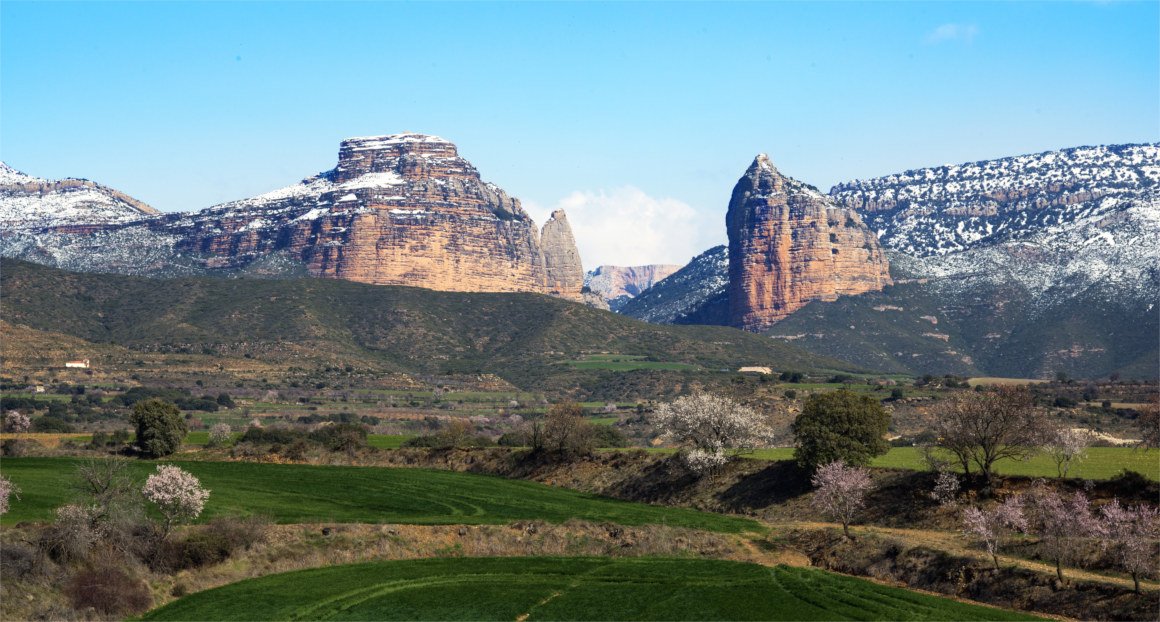
These great vertical walls are spectacular to see and could not be better for climbing. Their rounded shape is formed by rocks or conglomerate formations, known here as “MALLOS”, typical of La Hoya de Huesca.
As you may already have seen in the attractive pictures, some of them are reddish in colour caused by the iron minerals they contain. This colouring is accentuated at sunset.
A visit to the Mallos of Riglos, Vadiello and Agüero, and also to the Salto de Roldán, is ideal for watching birds of prey, for enjoying nature in a perfect state of conservation, for climbing and for relaxing your eyes with this unique panorama.
The views over the synclines and the town houses are impressive and unique. They can be seen from several places in the territory. Some of them, such as sundown from Murillo, or the more extensive view from the Eagle Look-out, afford a beautiful scene.
These vertical walls, rising to 300 metres in height, close to the village and the Gállego river, are limestone conglomerates formed in the Tertiary era. Later on they were eroded by water, rain and wind to form the walls you can see today; these are reddish in colour because of the iron minerals and clay they contain and are quite spectacular at sundown. The Riglos Synclines include the following crags: the Puro, Pisón, Visera and Firé.
Riglos and its ridged cliff formations are a paradise for climbers. They are internationally famous amongst climbing enthusiasts. They are also a paradise for birds of prey who nest and breed in the many hollows in the ridges. These birds, mainly protected birds of prey, can be seen flying over the territory.
To complete your visit, go to the Bird of Prey Interpretation Centre in Riglos, ARCAZ, where you will find ample information on the Griffon vulture.
These stone monoliths rise majestically close to the town of Agüero and they give the place its identity.
These ridges are formed by conglomerates that originated in the accumulation of solid particles from the destruction of some of the Pyrenees peaks; the Gállego river deposited these at the foot of the mountain, thus forming a large refuse cone. The way they look today is because of erosion. Their shape and height make them an ideal place for climbing and other sports, as well as for the observation of bird colonies nesting in these surroundings.
Amongst these formations, the Sola Crag monolith, created by the fracture of a large mass of rock, rises to 200 metres on its west slope. If you wish to climb the Sola Crag there are several ways. The ridges are not too high, but they are perhaps not sufficiently close together for this sport.
In these unique, particularly beautiful surroundings, with the Vadiello dam in the centre, you can appreciate the conglomerate rock formations, great isolated vertical ridged walls, known as the synclines. The ones in this place are the Ligüerri Synclines and they are dominated by the Mitra and Puro monoliths, as well as the Isarre Gorge with the San Chinés hermitage. Another of the symbolic crags in Vadiello is the “San Cosme Egg”. The list is long: the Potato, the Pepes, also known as the Aliana Synclines, Lazas, the Borón Crests, the San Jorge Peak, as well as the Escomentué, Diablo and Lazas gorges, and the Palomo Canal, where there a great many Griffon vultures.
The formations in these synclines are rounded and form an ideal rocky mass for climbing enthusiasts.
Close to the city of Huesca, this place was named in honour of one of the most legendary characters of the Middle Ages, the valiant French knight, Roldán. It has some imposing rock walls from which you can sight magnificent countryside and it is in the north-western sector of the Sierra Natural Park and the Guara Canyons. Legend has it that when Roldán, at the head of the rearguard of the Carolingian Army, withdrew towards France, pursued from the south, he was ambushed at the San Miguel Crag. To escape from his persecutors, he spurred his horse to jump (a salto) over the gorge, reaching the crag on the opposite side. The hoof prints are embedded in the rock.
The Salto de Roldán is formed by two impressive ridged wall faces - the San Miguel Crag and the Amán Crag; they are both steep conglomerate formations with the Flumen River at the bottom.The river eroded the synclines at different levels of the conglomerate deposits during the Tertiary period. All the synclines have varying degrees of hardness. Sometimes the rock fractures to form isolated synclines, as is the case of the Fraile Crag.
This type of geological environment, with its variety of air currents, is the favourite habitat of many birds of prey, in particular the Griffon vulture, that find refuge in the hollows of the rocks.